The global absorbable PGLA surgical sutures market is expected to increase from USD 213.4 million in 2025 to USD 334.5 million by 2035, advancing at a CAGR of 4.6%. This expansion reflects a decade where wound closure methods undergo significant refinement, supported by broader adoption of bioabsorbable polymer solutions and advanced suture technologies across hospitals, ambulatory surgical centers, and specialty facilities. With an overall increase of USD 121.1 million, the absorbable PGLA surgical sutures market demonstrates how clinical practice is steadily moving toward next-generation absorbable systems.
In the early phase of the forecast, spanning 2025 to 2030, the absorbable PGLA surgical sutures market is set to rise from USD 213.4 million to around USD 269.8 million. This represents USD 56.4 million in new value, accounting for nearly 47% of the projected growth. This period will be defined by strong momentum in monofilament PGLA sutures as surgeons prioritize predictable absorption and improved tensile performance. Handling convenience and superior knot security will no longer be differentiators but expected standards, particularly in complex surgical fields such as obstetrics, gynecology, and general surgery.
The latter phase, from 2030 to 2035, contributes an additional USD 64.7 million, bringing the absorbable PGLA surgical sutures market to USD 334.5 million. This period contributes 53% of the total decade’s growth, showing a stronger second-half push compared with the earlier years. Market progress in this stage will be tied to broad acceptance of coating innovations that enhance suture smoothness, biocompatibility, and surgical outcomes. Integration with minimally invasive surgical protocols and widespread use in specialty applications such as urology highlight the expanding utility of PGLA sutures.
Across the decade, the evolution of absorbable PGLA sutures demonstrates how innovation and clinical preference converge. What begins as the accelerated adoption of monofilament systems transitions into a more mature phase marked by coating enhancements and protocol integration. This two-stage trajectory reveals a consistent demand base while underscoring shifts in quality expectations among surgeons and medical facilities. By 2035, the absorbable PGLA surgical sutures market’s transformation highlights its role as a cornerstone of surgical wound management, ensuring both functionality and patient comfort. Growth is not only a matter of volume but also of technological sophistication, with industry participants positioned to benefit from sustained demand across diverse surgical specialty areas.
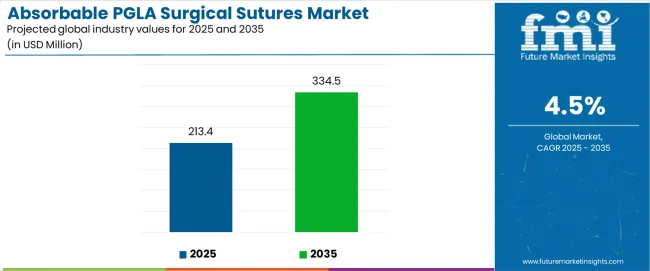
The absorbable PGLA surgical sutures market demonstrates distinct growth phases with varying technological characteristics and surgical adoption dynamics. Between 2025 and 2030, the absorbable PGLA surgical sutures market progresses through its advanced polymer integration phase, expanding from USD 213.4 million to USD 269.8 million with steady annual increments averaging 4.8% growth. This period showcases the transition from basic PGLA formulations to advanced coated systems with enhanced absorption profiles and integrated antimicrobial properties becoming mainstream features.
The 2025-2030 phase adds USD 56.4 million to market value, representing 47% of total decade expansion. Market maturation factors include standardization of absorption timeframes, declining material costs for specialized polymer coatings, and increasing surgeon awareness of PGLA benefits reaching 80-85% effectiveness in wound healing applications. Competitive landscape evolution during this period features established manufacturers like Johnson & Johnson and Ethicon LLC expanding their product portfolios while new entrants focus on specialized coating solutions and enhanced biocompatibility technology.
From 2030 to 2035, market dynamics shift toward advanced customization and multi-specialty deployment, with growth accelerating from USD 269.8 million to USD 334.5 million, adding USD 64.7 million or 53% of total expansion. This phase transition logic centers on universal high-performance systems, integration with robotic surgical platforms, and deployment across diverse surgical scenarios, becoming standard rather than specialized suture formats. The competitive environment matures with focus shifting from basic absorption to comprehensive handling performance and compatibility with modern minimally invasive techniques.
At-a-Glance Metrics
| Metric | Value |
|---|---|
| Market Value (2025) | USD 213.4 million |
| Market Forecast (2035) | USD 334.5 million |
| Growth Rate | 4.60% CAGR |
| Leading Suture Type | Monofilament |
| Primary Application | General Surgery Segment |
The absorbable PGLA surgical sutures market demonstrates strong fundamentals with monofilament systems capturing a dominant share through superior handling characteristics and predictable absorption capabilities. General surgery applications drive primary demand, supported by increasing surgical procedure volumes and enhanced wound closure management solutions. Geographic expansion remains concentrated in developed markets with established healthcare infrastructure, while emerging economies show accelerating adoption rates driven by healthcare modernization projects and rising surgical procedure activity.
The absorbable PGLA surgical sutures market represents a compelling intersection of surgical innovation, polymer technology advancement, and wound closure optimization management. With robust growth projected from USD 213.4 million in 2025 to USD 334.5 million by 2035 at a 4.60% CAGR, this market is driven by increasing surgical procedure expansion trends, minimally invasive surgery requirements, and hospital demand for reliable wound closure formats.
The absorbable PGLA surgical sutures market's expansion reflects a fundamental shift in how surgeons and medical facilities approach surgical wound management. Strong growth opportunities exist across diverse surgical applications, from general surgery operations requiring versatile suture solutions to specialized procedures demanding high-performance materials. Geographic expansion is particularly pronounced in Asia-Pacific markets, led by China (6.2% CAGR) and India (5.8% CAGR), while established markets in North America and Europe drive innovation and specialized segment development.
The dominance of monofilament systems and general surgery applications underscores the importance of proven polymer technology and surgical reliability in driving adoption. Absorption timing and manufacturing precision remain key challenges, creating opportunities for companies that can deliver consistent performance while maintaining cost efficiency.
Market expansion rests on three fundamental shifts driving adoption across surgical specialties and healthcare facilities. Healthcare modernization creates compelling advantages through PGLA suture systems that provide comprehensive wound closure with predictable absorption characteristics, enabling surgeons to achieve optimal healing outcomes while ensuring procedural efficiency and justifying investment over traditional suture methods. Surgical technique advancement accelerates as medical facilities worldwide seek reliable closure systems that deliver surgical precision directly to operative procedures, enabling improved patient outcomes that align with healthcare quality expectations and maximizes procedural efficiency. Aging population demographics drive adoption from healthcare systems requiring advanced wound closure solutions that maximize healing capacity while maintaining biocompatible performance during tissue integration and recovery operations.
Primary Classification: The market segments by suture type into monofilament, braided, and specialty configurations, representing the evolution from basic PGLA formulations to advanced multi-component formats for comprehensive surgical applications.
Secondary Breakdown: Application segmentation divides the absorbable PGLA surgical sutures market into general surgery, obstetrics and gynecology, urology, cardiovascular surgery, orthopedic surgery, and other specialized procedures, reflecting distinct requirements for tensile strength, absorption timing, and handling characteristics.
Tertiary Classification: End-user segmentation encompasses hospitals, ambulatory surgical centers, specialty clinics, and surgical facilities, addressing varying volume requirements and procedural complexity needs.
Regional Classification: Geographic distribution covers North America, Europe, Asia Pacific, Latin America, and the Middle East & Africa, with developed markets leading adoption while emerging economies show accelerating growth patterns driven by healthcare infrastructure development programs.
The segmentation structure reveals technology progression from standard monofilament formats toward integrated coating platforms with enhanced handling and biocompatible capabilities, while application diversity spans from routine procedures to complex surgical operations requiring comprehensive wound closure and predictable absorption solutions.
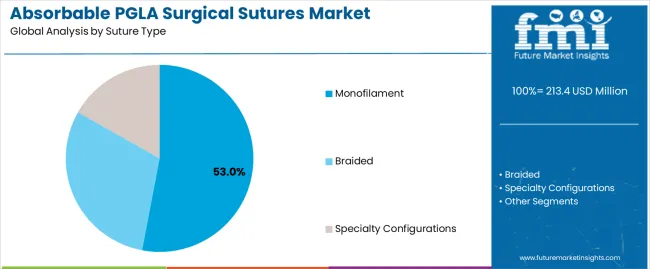
Monofilament segment is estimated to account for 53% of the absorbable PGLA surgical sutures market share in 2025. The segment's leading position stems from its fundamental role as a critical component in surgical applications and its extensive use across multiple general surgery and specialized procedures. Monofilament's dominance is attributed to its superior handling characteristics, including excellent knot security, reduced tissue drag, and predictable absorption timing that make it indispensable for everyday surgical operations.
Market Position: Monofilament systems command the leading position in the absorbable PGLA surgical sutures market through advanced polymer processing technologies, including comprehensive diameter control, uniform coating application, and reliable manufacturing performance that enable surgeons to deploy closure solutions across diverse surgical environments.
Value Drivers: The segment benefits from surgeon preference for proven suture profiles that provide exceptional handling without requiring premium material costs. Efficient manufacturing processes enable deployment in general surgery, specialty procedures, and minimally invasive applications where reliability and cost efficiency represent critical selection requirements.
Competitive Advantages: Monofilament systems differentiate through excellent knot-holding capacity, minimal tissue reaction, and compatibility with standard surgical instruments that enhance procedural capabilities while maintaining economical material profiles suitable for diverse surgical applications.
Key market characteristics:
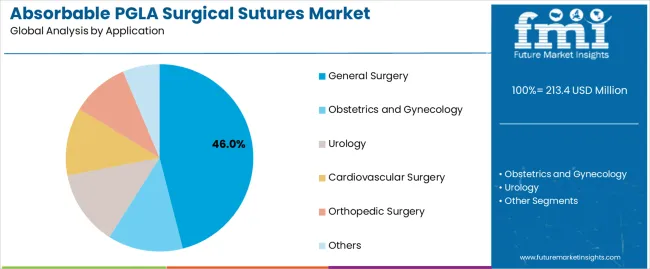
General surgery segment is projected to hold 46% of the absorbable PGLA surgical sutures market share in 2025. The segment's market leadership is driven by the extensive use of PGLA sutures in abdominal procedures, soft tissue repair, wound closure applications, and routine surgical operations, where bioabsorbable polymers serve as both a closure mechanism and healing facilitator. The general surgery sector's consistent demand for reliable suture materials supports the segment's dominant position.
Market Context: General surgery applications dominate the absorbable PGLA surgical sutures market due to widespread adoption of absorbable solutions and increasing focus on surgical efficiency, wound healing optimization, and patient comfort that enhance procedural outcomes while maintaining clinical standards.
Appeal Factors: Surgical teams prioritize predictable absorption, minimal tissue reaction, and compatibility with standard surgical protocols that enable coordinated deployment across multiple procedural needs. The segment benefits from substantial procedure growth and healthcare facility modernization that emphasize reliable closure systems for general surgical applications.
Growth Drivers: Hospital surgical departments incorporate PGLA sutures as standard components for abdominal procedures and tissue repair operations, while surgical efficiency initiatives increase demand for materials that comply with clinical protocols and enhance patient outcomes.
Market Challenges: Raw material cost fluctuations and absorption timing standardization may limit deployment flexibility in ultra-cost-sensitive markets or regions with varying surgical requirements.
Application dynamics include:
Growth Accelerators: Healthcare infrastructure expansion drives primary adoption as PGLA suture systems provide exceptional biocompatibility that enables wound closure without material removal procedures, supporting surgical efficiency and patient comfort that require reliable polymer formats. Surgical procedure growth accelerates market expansion as medical facilities seek advanced closure solutions that maintain healing optimization during recovery while enhancing procedural convenience through predictable absorption timing and tissue compatibility. Surgeon awareness increases worldwide, creating sustained demand for bioabsorbable closure systems that complement modern surgical techniques and provide clinical advantages in wound healing efficiency.
Growth Inhibitors: Raw material volatility challenges differ across polymer markets regarding price stability and supply chain consistency, which may limit margin predictability and cost planning in price-sensitive healthcare categories with demanding affordability requirements. Regulatory complexity persists regarding medical device standards and biocompatibility testing that may increase manufacturing costs in jurisdictions with strict healthcare regulatory protocols. Market fragmentation across multiple absorption timeframes and sizing standards creates compatibility concerns between different surgical protocols and existing procedural infrastructure.
Market Evolution Patterns: Adoption accelerates in general surgery and specialty procedure sectors where clinical benefits justify material investments, with geographic concentration in developed healthcare markets transitioning toward mainstream adoption in emerging economies driven by healthcare modernization and surgical facility development. Technology advancement focuses on enhanced polymer formulations, improved coating systems, and integration with minimally invasive platforms that optimize surgical performance and manufacturing consistency. The absorbable PGLA surgical sutures market could face disruption if alternative wound closure methods or regulatory changes significantly challenge traditional PGLA suture advantages in surgical applications.
The absorbable PGLA surgical sutures market demonstrates varied regional dynamics with growth leaders including China (6.2% CAGR) and India (5.8% CAGR) driving expansion through healthcare modernization and surgical facility development. Steady performers encompass Germany (5.3% CAGR), Brazil (4.8% CAGR), the USA (4.4% CAGR), the UK (3.9% CAGR), and Japan (3.5% CAGR), benefiting from established healthcare systems and advanced surgical adoption.
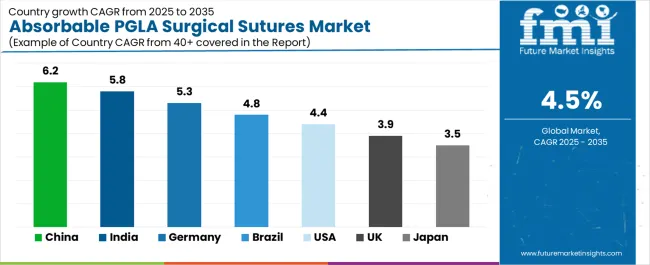
| Country | CAGR (2025-2035) |
|---|---|
| China | 6.2% |
| India | 5.8% |
| Germany | 5.3% |
| Brazil | 4.8% |
| USA | 4.4% |
| UK | 3.9% |
| Japan | 3.5% |
Regional synthesis reveals Asia-Pacific markets leading growth through healthcare infrastructure expansion and surgical procedure development, while European countries maintain steady expansion supported by specialized applications and medical device compliance requirements. North American markets show strong growth driven by hospital demand and surgical facility upgrades.
China establishes regional leadership through rapid healthcare modernization and comprehensive surgical facility development, integrating advanced PGLA suture systems as standard components in hospital procedures and specialized medical operations. The country's 6.2% CAGR through 2035 reflects healthcare investment promoting medical infrastructure and surgical capability development that mandate the use of reliable bioabsorbable systems in medical operations. Growth concentrates in major metropolitan areas, including Beijing, Shanghai, and Guangzhou, where hospital networks showcase integrated PGLA suture systems that appeal to medical facilities seeking enhanced surgical efficiency and international healthcare standards.
Chinese manufacturers are developing innovative PGLA suture solutions that combine local production advantages with international quality specifications, including advanced coating technologies and specialized absorption capabilities.
Strategic Market Indicators:
The Indian market emphasizes surgical applications, including rapid healthcare development and comprehensive medical facility expansion that increasingly incorporates PGLA sutures for general surgery and specialized procedures. The country is projected to show a 5.8% CAGR through 2035, driven by massive healthcare activity under medical infrastructure initiatives and hospital demand for standardized, high-quality surgical materials. Indian medical facilities prioritize cost-effectiveness with PGLA sutures delivering clinical efficiency through economical material usage and reliable performance capabilities.
Technology deployment channels include major hospitals, surgical centers, and medical device distributors that support high-volume usage for domestic and specialty applications.
Performance Metrics:
The German market emphasizes advanced PGLA suture features, including innovative polymer technologies and integration with comprehensive surgical platforms that manage general surgery, specialty procedures, and minimally invasive applications through unified closure systems. The country is projected to show a 5.3% CAGR through 2035, driven by medical facility expansion under healthcare excellence trends and hospital demand for premium, reliable surgical materials. German hospitals prioritize clinical outcomes with PGLA sutures delivering comprehensive wound closure through enhanced biocompatibility and procedural innovation.
Technology deployment channels include major medical device distributors, surgical centers, and hospital systems that support custom development for premium operations.
Performance Metrics:
In São Paulo, Rio de Janeiro, and Brasília, Brazilian medical facilities and hospital operators are implementing advanced PGLA suture systems to enhance surgical capabilities and support clinical efficiency that aligns with healthcare protocols and procedural standards. The Brazilian market demonstrates sustained growth with a 4.8% CAGR through 2035, driven by healthcare expansion programs and medical investments that emphasize reliable surgical systems for general surgery and specialty applications. Brazilian hospitals are prioritizing PGLA suture systems that provide exceptional clinical performance while maintaining compliance with medical standards and minimizing procedural complexity, particularly important in hospital surgical departments and specialty medical operations.
Market expansion benefits from healthcare programs that mandate enhanced surgical materials in medical specifications, creating sustained demand across Brazil's hospital and specialty sectors, where wound healing and material consistency represent critical requirements.
Strategic Market Indicators:
The USA market emphasizes advanced surgical applications, with documented clinical excellence in hospital procedures and specialty operations through integration with existing surgical protocols and quality assurance infrastructure. The country leverages medical expertise in polymer technology and surgical materials to maintain market leadership. Medical centers, including those in California, Texas, and New York, showcase advanced installations where PGLA suture systems integrate with comprehensive surgical platforms and procedural systems to optimize wound closure and clinical efficiency.
American medical facilities prioritize surgical precision and material consistency in product selection, creating demand for premium PGLA suture systems with advanced features, including specialized coatings and integration with minimally invasive protocols. The absorbable PGLA surgical sutures market benefits from established healthcare infrastructure and willingness to invest in specialized polymer technologies that provide superior clinical performance and regulatory compliance.
Market Intelligence Brief:
The UK market demonstrates sophisticated surgical deployment, growing at 3.9% CAGR, with documented clinical excellence in hospital procedures and specialty applications through integration with existing surgical systems and healthcare infrastructure. The country leverages medical expertise in surgical materials and clinical protocols to maintain market position. Medical centers, including those in London, Manchester, and Birmingham, showcase advanced installations where PGLA suture systems integrate with comprehensive surgical platforms and quality systems to optimize procedural efficiency and clinical outcomes.
British medical facilities prioritize clinical precision and material reliability in product selection, creating demand for specialized PGLA suture systems with advanced features, including enhanced biocompatibility and integration with evidence-based protocols. The absorbable PGLA surgical sutures market benefits from established healthcare systems and focus on clinical outcomes that provide superior surgical performance and regulatory adherence.
Performance Metrics:
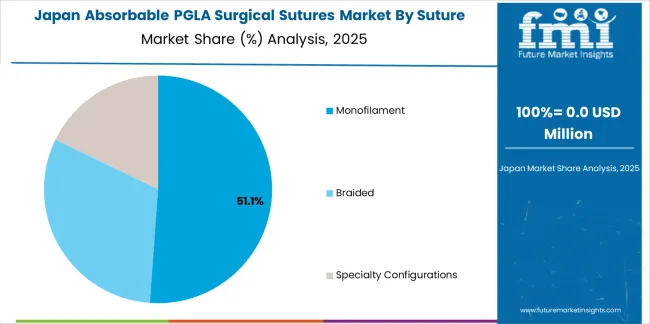
Japan's sophisticated medical device market demonstrates meticulous PGLA suture deployment, growing at 3.5% CAGR, with documented clinical excellence in hospital procedures and specialty applications through integration with existing surgical protocols and quality assurance infrastructure. The country leverages engineering expertise in polymer manufacturing and medical device production to maintain market leadership. Medical centers, including Tokyo, Osaka, and Nagoya, showcase advanced installations where PGLA suture systems integrate with comprehensive surgical platforms and quality systems to optimize wound closure and clinical efficiency.
Japanese medical facilities prioritize surgical precision and material consistency in product selection, creating demand for premium PGLA suture systems with advanced features, including ultra-precise manufacturing and integration with specialized surgical protocols. The absorbable PGLA surgical sutures market benefits from established medical infrastructure and willingness to invest in specialized polymer technologies that provide superior clinical properties and regulatory compliance.
Market Intelligence Brief:
The absorbable PGLA surgical sutures market in Europe is projected to grow from USD 58.7 million in 2025 to USD 85.2 million by 2035, registering a CAGR of 3.8% over the forecast period. Germany is expected to maintain its leadership position with a 42.1% market share in 2025, declining slightly to 41.8% by 2035, supported by its medical device excellence and major surgical centers, including Bavaria and North Rhine-Westphalia.
France follows with a 23.6% share in 2025, projected to reach 24.1% by 2035, driven by comprehensive hospital surgical programs and medical facility initiatives. The United Kingdom holds a 18.4% share in 2025, expected to maintain 18.7% by 2035 through established healthcare sectors and surgical procedure adoption. Italy commands an 11.2% share, while Spain accounts for 3.9% in 2025. The Rest of Europe region is anticipated to gain momentum, expanding its collective share from 0.8% to 1.2% by 2035, attributed to increasing healthcare development in Eastern European countries and emerging medical programs implementing standardized surgical systems.
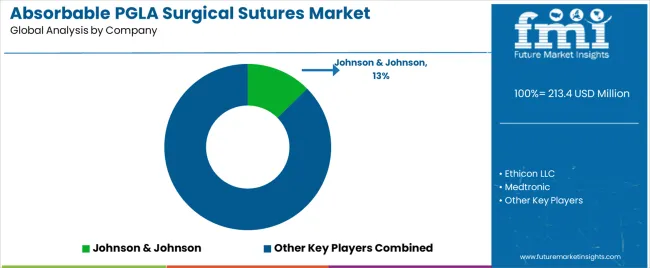
The absorbable PGLA surgical sutures market operates with moderate concentration, featuring approximately 15-20 participants, where leading companies control roughly 55-62% of the global market share through established medical distribution networks and comprehensive surgical product portfolio capabilities. Competition emphasizes absorption predictability, handling characteristics, and clinical reliability rather than premium feature rivalry.
Market leaders encompass Johnson & Johnson, Ethicon LLC, and Medtronic, which maintain competitive advantages through extensive surgical materials expertise, global medical distribution networks, and comprehensive clinical support capabilities that create surgeon loyalty and support hospital requirements. These companies leverage decades of polymer manufacturing experience and ongoing surgical technology investments to develop advanced PGLA suture systems with exceptional biocompatibility and clinical features.
Specialty challengers include B. Braun, Peters Surgical, and DemeTech, which compete through specialized surgical innovation focus and efficient manufacturing solutions that appeal to medical buyers seeking reliable performance formats and custom sizing flexibility. These companies differentiate through clinical efficiency emphasis and specialized market focus.
Market dynamics favor participants that combine consistent clinical performance with advanced manufacturing support, including sterile packaging and medical distribution capabilities. Competitive pressure intensifies as traditional medical device manufacturers expand into PGLA suture systems, while specialized surgical companies challenge established players through innovative polymer formulations and cost-effective production targeting emerging hospital segments.
| Item | Value |
|---|---|
| Quantitative Units | USD 213.4 million |
| Suture Type | Monofilament, Braided, Specialty Configurations |
| Application | General Surgery, Obstetrics and Gynecology, Urology, Cardiovascular Surgery, Orthopedic Surgery, Others |
| End User | Hospitals, Ambulatory Surgical Centers, Specialty Clinics, Surgical Facilities |
| Regions Covered | North America, Europe, Asia Pacific, Latin America, Middle East & Africa |
| Countries Covered | USA, Germany, Japan, China, India, Brazil, UK, and 20+ additional countries |
| Key Companies Profiled | Johnson & Johnson, Ethicon LLC, Medtronic, B. Braun, Peters Surgical, DemeTech |
| Additional Attributes | Dollar sales by suture type and application categories, regional adoption trends across North America, Europe, and Asia-Pacific, competitive landscape with medical device manufacturers and surgical specialists, surgeon preferences for absorption characteristics and handling performance, integration with surgical protocols and procedural systems, innovations in polymer technology and coating systems, and development of specialized surgical solutions with enhanced biocompatibility and predictable absorption features |
The global absorbable PGLA surgical sutures market is estimated to be valued at USD 213.4 million in 2025.
The market size for the absorbable PGLA surgical sutures market is projected to reach USD 334.5 million by 2035.
The absorbable PGLA surgical sutures market is expected to grow at a 4.5% CAGR between 2025 and 2035.
The key product types in absorbable PGLA surgical sutures market are monofilament, braided and specialty configurations.
In terms of application, general surgery segment to command 46.0% share in the absorbable PGLA surgical sutures market in 2025.






Our Research Products

The "Full Research Suite" delivers actionable market intel, deep dives on markets or technologies, so clients act faster, cut risk, and unlock growth.

The Leaderboard benchmarks and ranks top vendors, classifying them as Established Leaders, Leading Challengers, or Disruptors & Challengers.

Locates where complements amplify value and substitutes erode it, forecasting net impact by horizon

We deliver granular, decision-grade intel: market sizing, 5-year forecasts, pricing, adoption, usage, revenue, and operational KPIs—plus competitor tracking, regulation, and value chains—across 60 countries broadly.

Spot the shifts before they hit your P&L. We track inflection points, adoption curves, pricing moves, and ecosystem plays to show where demand is heading, why it is changing, and what to do next across high-growth markets and disruptive tech

Real-time reads of user behavior. We track shifting priorities, perceptions of today’s and next-gen services, and provider experience, then pace how fast tech moves from trial to adoption, blending buyer, consumer, and channel inputs with social signals (#WhySwitch, #UX).

Partner with our analyst team to build a custom report designed around your business priorities. From analysing market trends to assessing competitors or crafting bespoke datasets, we tailor insights to your needs.
Supplier Intelligence
Discovery & Profiling
Capacity & Footprint
Performance & Risk
Compliance & Governance
Commercial Readiness
Who Supplies Whom
Scorecards & Shortlists
Playbooks & Docs
Category Intelligence
Definition & Scope
Demand & Use Cases
Cost Drivers
Market Structure
Supply Chain Map
Trade & Policy
Operating Norms
Deliverables
Buyer Intelligence
Account Basics
Spend & Scope
Procurement Model
Vendor Requirements
Terms & Policies
Entry Strategy
Pain Points & Triggers
Outputs
Pricing Analysis
Benchmarks
Trends
Should-Cost
Indexation
Landed Cost
Commercial Terms
Deliverables
Brand Analysis
Positioning & Value Prop
Share & Presence
Customer Evidence
Go-to-Market
Digital & Reputation
Compliance & Trust
KPIs & Gaps
Outputs
Full Research Suite comprises of:
Market outlook & trends analysis
Interviews & case studies
Strategic recommendations
Vendor profiles & capabilities analysis
5-year forecasts
8 regions and 60+ country-level data splits
Market segment data splits
12 months of continuous data updates
DELIVERED AS:
PDF EXCEL ONLINE
Absorbable PGA Surgical Sutures Market Size and Share Forecast Outlook 2025 to 2035
Absorbable Surgical Suture with Needle Market Size and Share Forecast Outlook 2025 to 2035
USA Knotless Surgical Sutures Market Analysis – Share, Size, and Forecast 2025 to 2035
Surgical Tourniquet Market Size and Share Forecast Outlook 2025 to 2035
Surgical Operating Microscope Market Forecast and Outlook 2025 to 2035
Surgical Heart Valves Market Size and Share Forecast Outlook 2025 to 2035
Surgical Aspirators Market Size and Share Forecast Outlook 2025 to 2035
Surgical Robot Procedures Market Size and Share Forecast Outlook 2025 to 2035
Surgical Wound Care Market Size and Share Forecast Outlook 2025 to 2035
Surgical Retractors Market Size and Share Forecast Outlook 2025 to 2035
Surgical Drainage Devices Market Size and Share Forecast Outlook 2025 to 2035
Surgical Booms Market Insights - Size, Share & Industry Growth 2025 to 2035
Surgical Scissors Market Size and Share Forecast Outlook 2025 to 2035
Surgical Instruments Tracking System Market Growth - Trends & Forecast 2025 to 2035
Surgical Instruments Packaging Market Size, Share & Forecast 2025 to 2035
Surgical Monitors Market Analysis - Industry Insights & Forecast 2025 to 2035
Surgical Scalpels Market Trends – Growth & Forecast 2025-2035
Surgical Generators Market – Trends & Forecast 2025 to 2035
Surgical Clips Market Analysis - Size, Share & Forecast 2025 to 2035
Surgical Gloves Market Trends - Size, Demand & Forecast 2025 to 2035

Thank you!
You will receive an email from our Business Development Manager. Please be sure to check your SPAM/JUNK folder too.
Chat With
MaRIA